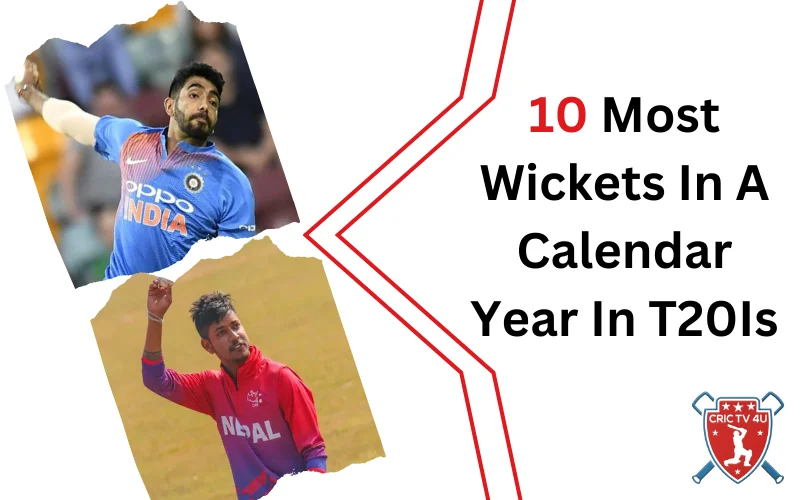The popularity of T20 cricket has skyrocketed in recent years, and with it, so have the records. The most wickets taken in a calendar year is one of the most sought-after milestones in T20 cricket. A few talented bowlers stand out in a format where hitters predominate, thanks to their fantastic T20I exploits. With T20I cricket becoming increasingly popular worldwide, several new and gifted bowlers have emerged. Even the well-known bowlers from the top teams are facing fierce competition from these bowlers. The top 10 bowlers who have taken the most wickets in T20Is in a calendar year will be examined in this article.
1. Alpesh Ramjani (Uganda)
Of the total 56 wickets that Alpesh Ramjani has in T20I cricket, 51 have come in this year. He has taken them in just 26 matches, with a best figure of 4/9. His skills are highlighted from this, and his ability to take these many wickets showcases that he has a bright future ahead.

2. Yalinde Nkanya (Tanzania)
In 2022, Yalinde Nkanya demonstrated an outstanding bowling performance with an average of 8.60. Throughout the year, he played in 28 matches and took an impressive 45 wickets. His best figures during this period were 5/2, which included two four-wicket hauls and one five-wicket haul. These statistics indicate that he is an excellent bowler, capable of taking crucial wickets.

3. Wanindu Hasaranga (Sri Lanka)
Wanindu Hasaranga had a remarkable year with the ball in 2021, which contributed to establishing him as an outstanding T20 bowler. In the 20 matches he played, Hasaranga took an impressive 36 wickets at an average of less than 12, with his best bowling figures being 4/9. His performance reflects his exceptional skill and impact as a T20 bowler.

4. Lungi Ngidi (South Africa)
With the pandemic forcing the world to shut down, there was not a lot of cricket in 2020. In the few T20Is played, Lungi Ngidi emerged as the leading wicket-taker with 17 wickets in 9 matches. The best figures in his tally were 3/30, at an average of just over 20. His figures are impressive for a fast bowler.

5. Sandeep Lamichhane (Nepal)
Sandeep Lamichhane, had an outstanding year in 2019, finishing as the top wicket-taker in T20 cricket. Despite playing only 16 matches, he took 28 wickets at an average of 13.71, with his best figures being 4/20. Lamichhane's impressive performance reflects his exceptional skill and impact as a T20 bowler.

6. Andrew Tye (Australia)
Andrew Tye emerged as a promising T20 bowler in 2018, mainly due to his ability to bowl the knuckleball. Playing 19 matches and taking 31 wickets at an average of just under 19. His best figures during this period were 4/23. Tye's impressive performance helped establish him as a valuable asset in T20 cricket.

7. Yuzvendra Chahal (India)
Cementing his place in the Indian squad for the years to come, Yuzi Chahal delivered the best performance in T20Is in 2017. He played 11 matches and took 23 wickets in total. He had an incredible average of 14.13 and bagged career-best figures of 6/25. Chahal has been a critical bowler for India for many years now.

8. Jasprit Bumrah (India)
Jasprit Bumrah, who has emerged as the most dependable bowler across formats for India, was the leading wicket-taker in T20Is in 2016. He played 21 matches and took 28 wickets, averaging just under 19. He also registered his career-best figures in the year with 3/11.

9. Ahsan Malik (Netherlands)
Ahsan Malik, a Dutch cricketer, succeeded significantly in T20 internationals in 2015. He emerged as the top wicket-taker in the year, securing 16 wickets in seven matches with career-best figures of 4/21 and an impressive average of 10.69. Notably, he took eleven wickets against Nepal in four T20I matches in July 2015.

10. Samuel Badree (West Indies)
In 2014, Samuel Badree represented the West Indies in 12 T20Is, where he demonstrated an impressive performance by securing 19 wickets at an average of 12.37, with a career-best of 4/15. His exceptional bowling skills and accuracy made him a valuable asset to the team, and he continued to excel in the T20 format in the following years.







